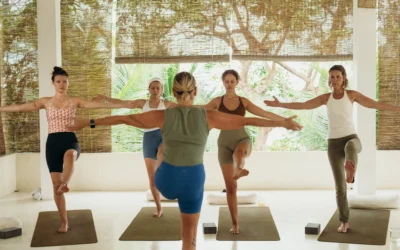When I discovered Yoga Synergy, I was already deep in the world of yoga—teaching, travelling, adjusting, and honestly, managing a collection of nagging injuries. I’d torn through Ashtanga, stood in Iyengar lines, and flowed through every kind of Vinyasa. But my body was stiff, tight, and sometimes just plain sore. Something wasn’t adding up.
That changed when I met Simon Borg-Olivier, an Australian yoga trainer and physiotherapist.
Simon—co-founder of Yoga Synergy—brought together the best of ancient yoga, Western anatomy, and Eastern movement science into a system that wasn’t just safer. It made more sense. It felt better. It helped me heal. And eventually, it changed how I teach.
This is the method I now share through my 200HR Yoga Teacher Trainings and online course. Here’s what makes it different—and why it works.
1. The Origins: Science Meets Tradition
Yoga Synergy didn’t start as a brand. It started as a question: “Does this pose, this transition, this breath actually benefit the human body—or are we just copying what we’ve been told?”
Simon spent decades training under B.K.S. Iyengar and Pattabhi Jois, studied Chinese martial arts and Qi Gong, then earned a Master’s in physiotherapy. What came out the other side was a movement system that filters every yoga technique through the lens of anatomy, physiology, and breath mechanics.
If a traditional method supported functional movement, it stayed. If it didn’t, it was adapted—or left behind.
2. The Core Principles of Yoga Synergy
There are four foundational principles that guide every class, every pose, every breath.
Move Actively
You place your body—don’t let gravity yank you into shapes.
→ Builds strength through full ranges of motion and reduces joint collapse.
Move from the Core
The spine initiates, limbs follow.
→ Creates integrated, spine-led movement with less tension and better control.
Move Fluidly
Transitions are smooth and wave-like—not robotic or rigid.
→ Reduces impact, supports joint health, and keeps blood and lymph moving freely.
Breathe Naturally
Inhale and exhale through the nose, led by the body—not forced from the brain.
→ Maintains nervous system calm and preserves optimal gas exchange.
Together, these build a practice that feels strong and calm at once, something I never experienced in my early years of “more stretch = better yoga.”
3. What a Yoga Synergy Class Feels Like
Every Yoga Synergy session follows a smart rhythm:
- Warm-Up
We begin with Spinal Synergy and Joint Synergy sequences to prepare the nervous system, joints and core. - Flow
Class unfolds through familiar shapes, but always with the four principles. You’ll feel stronger in each pose, even when moving slower. - Settle
Instead of collapsing into savasana, we finish with a neutral breath and reset—the kind that helps you feel lighter, not looser.
Even experienced students are surprised at how deep their practice goes when they stop forcing range and start moving with clarity.
4. Who This Works For
Beginners: No background in yoga? Perfect. You’ll learn patterns that make movement safer from day one.
Injured or cautious movers: The “stretch less, move smarter” philosophy lets you build strength while avoiding aggravation.
Seasoned yogis: Synergy fills the gaps—those subtle blind spots in standard Vinyasa or Hatha. It’s a new level of refinement.
Athletes: The method translates directly into surf, climbing, strength work and mobility flows—with less injury risk.
5. Why I Teach It
Because it works. I’ve seen it undo years of over-stretching. I’ve seen it give students agency over their movement. And I’ve seen it give yoga teachers the tools they wish they had from the beginning.
If you’re curious about applying science-backed movement principles to yoga—and life—this is where I’d start.
Want to Learn the Yoga Synergy Method?
- 🌐 Start today from home with my online course
- 📅 Or join me in Sri Lanka for the 200HR Yoga Synergy Teacher Training
Both options give you the full framework and real-world tools to teach—and move—smarter, longer, and with less pain.



